Our dacha is not just a factory for the production of fruits and vegetables, but also a place of rest, our second home. Arranging a garden, we think at the same time about the benefits and beauty. You can create a beautiful landscape in the country different ways. For example, by planting ornamental trees in the garden. Creating a composition of garden trees is not so difficult. And then it’s easier to take care of an ornamental garden than a vegetable garden or flower beds. What trees are suitable for a garden in the country?
Trees with a spherical crown
They look very good on plots of field maple varieties, Acer campestre "Rozi" and "Nanum". Its leaves are smaller than those of the Norway maple, with soft outlines. Yellow-red in spring, dark green in summer, bright yellow in autumn.
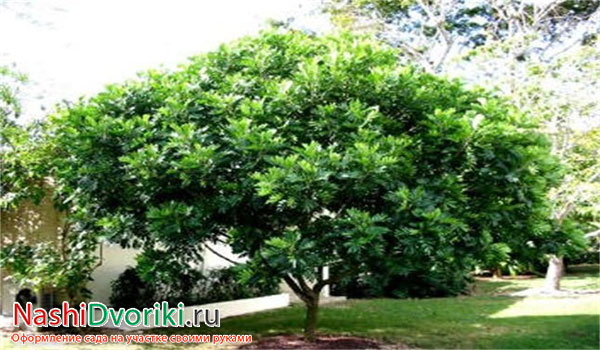
Varietal maples form a spherical or ovoid crown without any special pruning. Such an Acer campestre "Elsrijk". An adult tree reaches a height of 3.5 - 5 meters and a width of about 2 m. This maple is very resistant to droughts and frosts. Tolerates some shade, although photophilous. And it feels great in alley and group plantings, it also lends itself very well to topiary haircuts. From non-standard, that is, bush forms, amazing hedges are obtained. Such a maple serves as an excellent backdrop for flowering ornamental shrubs and flowers.
For larger plots and for large alleys suitable variety Norway maple Acer platanoides "Globosum". This is also a spherical maple. In spring, its leaves are bronze, in summer they are dark green, in autumn they are painted in yellow-orange tones. The tree is very stable, grows on any fertile soil, withstands frost and wind, and is durable. But he doesn't like flooding. Sometimes sanitary pruning may be needed in early spring.
Ornamental trees - white-flowering balls
Ornamental trees look gorgeous in the gardens - bird cherry Prunus padus "Nana". This tree, 3-4 meters high, has a dense spherical crown. Branches with the aroma of bitter almonds. The foliage is small, dark green in summer, crimson red in autumn. In May, the whole tree is simply strewn with white tassels of flowers. Then berries are formed, black and red, quite edible. Bird cherry is undemanding to soils, tolerates temporary dryness well and withstands frost.

For the southern regions, it will be even more interesting to look at the bignonium catalpa Catalpa bignonioides "Nana". It has large bright green leaves and an almost perfectly round crown.
One of the most unpretentious ornamental trees is the black locust or white locust. It tolerates drought, undemanding to soils. The variety Robinia "Umbraculifera" is very interesting - with the correct spherical crown. It grows quite slowly, but it's not bad. Over the years, the branches become more and more curved, which is especially attractive in winter, when the tree is without leaves.
For small gardens, shrub cherry Prunus eminens "Umbraculifera" is good, with a dense regular spherical crown. In spring, the whole is covered with white flowers, then covered with small glossy foliage. The height of an adult tree depends on the height of the rootstock. Like all cherries loves the sun and fertile soil.
The stem and grafting site needs protection from burns and rodents in the spring. Can be tied with reeds or non-woven fabric. Periodically carry out sanitary pruning. Such a shrub cherry will be an excellent decoration for a flower bed or lawn. You can land it as a tapeworm. And you can plant in a container and decorate gazebos and terraces. It will also grow well!
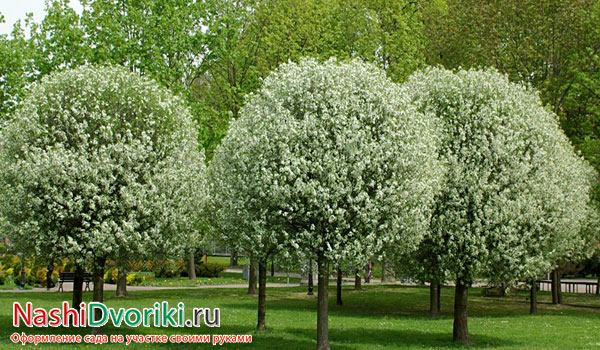
Unfortunately, very often in small dachas there is no fruit or ornamental garden. Only a few trees with a poorly formed crown grow along the fence under the wires. But to lay a garden of ornamental trees, so that it would be pleasant to manage and admire, is within the power of both novice summer residents and real lazy people!
And a few simple tips finally:
- plant low trees along power lines,
- small trees are good on the playground. They can be planted right next to a bench, swing or sandbox. So they will create a shadow in the summer heat and will not obscure the lawn, which is also needed.
See how many different garden planting options there are. Let your garden delight with its appearance in any season!
What other ornamental trees are suitable for creating a garden? We continue to select spectacular plants for the garden.
Ornamental trees with a weeping crown
Weeping tree forms look great in gardens. Imagine branches of white (silver) willow and Babylonian willow hanging down to the ground. These trees are quite large - up to 25 m in height and 10 m in width. Grow very fast. Best of all - on lit areas and fertile soils. They tolerate moisture quite well. Especially good on the shore of a large reservoir. Hanging branches lean towards the water itself and sway at the slightest breath of breeze.
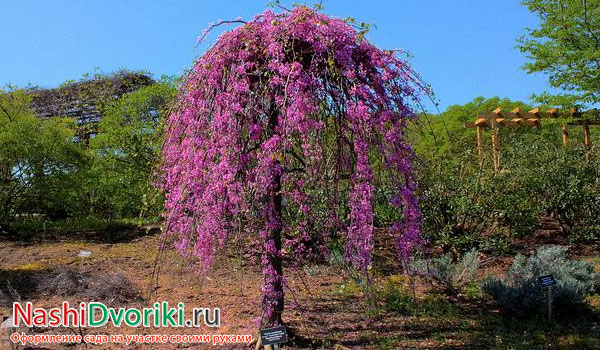
Of course, such large trees are suitable for large areas. For a small garden, a warty birch is suitable. Tree up to 5 m in height. Undemanding to care. Prefers loamy soils and without waterlogging. Birch will sometimes need to be treated for aphids.
Also good in the garden rowan ordinary. It also differs in unpretentiousness. Tolerates partial shade and requires minimal maintenance.
In the southern regions, you can plant a forest beech and a common hornbeam.
There is also a wonderful variety of weeping beech Fagus sulvatica "Purpurea Pendula". He will definitely draw attention to himself. What is the purple foliage of this tree.
As a tapeworm, the white mulberry Morus Alba "Pendula" looks very elegant in the summer cottage, besides, its sweet fruits are edible. Or you can plant weeping apple varieties Malus 'Pendula' or cherry blossoms Prunus subhirtella 'Pendula plena rosea'. In spring, the trees are covered with pink flowers. And in summer, the graceful branches of these trees reach the very ground, creating a living hut. So convenient for a green gazebo, summer bedroom or children's house.
A spreading crown with curving branches is given by Japanese Sophora, rough elm and common hazel.
Decorative trees - weeping miniatures
Are there more compact forms of weeping trees? Sometimes it is necessary to decorate the shore of a small summer cottage or stream. There is. Height up to 1.5-2 meters. It's all about the height of the vaccination. The goat willow will become a real decoration of the garden. It is also interesting in that in the spring, during flowering, everything is covered with fluffy earrings.

Like all willows, it tolerates floods well, loves fertile soils, but puts up with a lack of nutrition and watering. Pruning is needed only thinning. In addition, hanging branches can be shortened.
Very popular among gardeners and a small tree - tree-like caragana. The tree attracts with dark green openwork foliage and yellow hanging flowers. It grows well in sunny areas and in partial shade, unpretentious, can grow with light soil salinity.
Columnar ornamental trees
Previously, poplars were planted for landscaping city streets. Black poplar has the narrowest silhouette. Because of unpretentiousness and stability, poplar Bolle and poplar Simon, natives of Asia, were often planted.
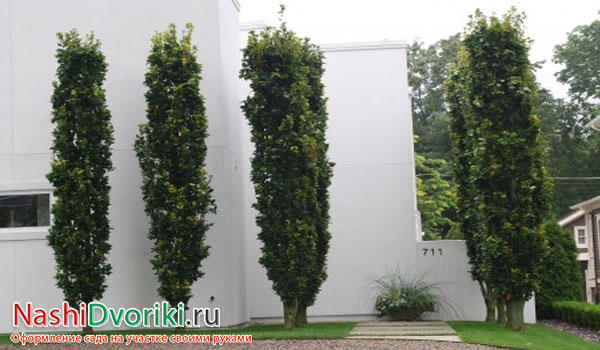
But to plant poplars in the country - real landowners can afford it.
There are more compact columns, such as Prunus "Amanogawa" sakura. There are also columnar varieties of Norway maple Acer platanoides "Columnare" and silver maple Acer saccharinum "Fastigiatum", as well as false acacia locust. By the way, Robinia is the best tree for landscaping poor soils.
Trees with a columnar crown can be planted in the form of alleys or along the perimeter of the site. In both cases, they will be a good protection from the winds. Such trees are good in compositions. For example, in combination with trees with a spherical crown.
The symbol of the Mediterranean is a slender cypress. But they are too cold in our climate. Other plants with a pyramidal crown will also help to create the necessary vertical accents in the garden. The choice is pretty good, agree?
The pedunculate oak is very picturesque in large areas. Reaches a height of 20 m, and a width of 3-4 meters. Initially, its crown is narrow, with age it becomes a huge wide column.
Also very good in large gardens and parks is the drooping birch Betula pendula "Festigiata". The crown is narrowly columnar, more compact than the original form. Her vertical shoots are also very beautiful: they are either wavy or twist in a spiral.
Decorative trees with curved branches
Too interesting option decorating gardens. Bizarrely curved curving shoots always attract attention. Like common hazel. It is also decorative in winter, when the foliage does not hide curved branches. And, of course, in spring, the whole tree is strewn with golden earrings.
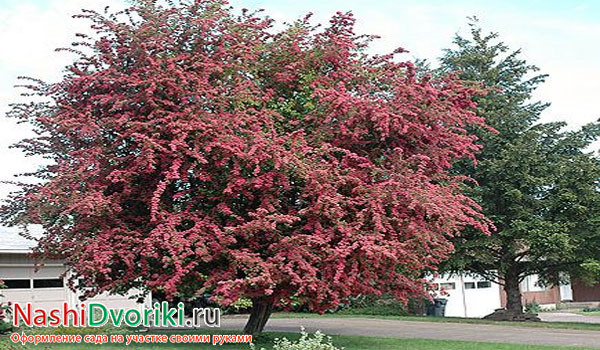
It is better to plant hazel in the center of a flower bed or lawn. It will also feel good on the shore of the reservoir. Prefers soils of moderate moisture, fertile, light or semi-shaded areas of the garden. Forms edible nuts in autumn. Hazel branches are very good in floral arrangements and dry bouquets.
The Udi willow looks interesting. This is a large, spreading shrub that blooms with golden-yellow catkins before the foliage blooms. It is better to place it in a visible place. For example, at a place of rest or a path. It also looks good in a mixborder among perennial herbaceous plants.
Now the best time for planning a future garden or park. As you can see, there are plenty to choose from!
Ornamental shrubs and trees are the most the best decoration your garden throughout the season - from early spring to late autumn. Trees are the basis of the site, so lawns and flower arrangements are placed around them.
How to choose the right ornamental shrubs for the garden and cottages?
Before choosing and buying ornamental flowering shrubs, you need to carefully consider where exactly on your site you will plant them. Because any planted tree on your site will not be one season, but decades.
You can easily update flower beds and lawns, but transplanting an adult tree is quite difficult. When choosing trees, it is necessary to take into account the conditions for growing, the size of a mature tree, the optimal distance between the trees, how quickly it will grow, and whether new plantings will be in harmony with each other and with the surrounding landscape.
Ornamental trees - the main decoration of the garden plot
Ornamental shrubs and trees, depending on the shape and color of the foliage, the height of the tree, the size of the crown, the color of the bark, can perform their function of decorating the garden in various options. For example, tall trees are best placed along the perimeter of the site or alone, while low trees and shrubs are the perfect frame for flower beds.
Ornamental trees with yellow, white or variegated foliage stand out against the background of the garden, so such trees must be positioned so that they can be clearly seen from anywhere in the garden. But trees with variegated foliage require more careful care. And it is best to combine them with trees that have green or silver leaves.
You can create harmony in the garden by picking up deciduous ornamental trees with different crown shapes. Together, these trees form a harmonious whole. A different shape of the crown: in the form of a cone or a ball, or weeping - can create a different visual effect or mood.
It is very difficult to create an ideal combination of trees even on a large garden plot - this requires certain skills and knowledge. It is even more difficult to do this in a small area. If the type of tree you like is large enough, then you can buy deciduous ornamental trees and coniferous trees grafted onto a trunk or pick up a stunted type of this tree in the Home Garden Online Store. In some cases, a haircut that correctly forms the crown can help. But not all types of deciduous trees can be sheared, some do not tolerate it at all.
The Home Garden online store presents a wide range of various varietal types of ornamental shrubs, including here you can buy shrubs for summer cottages and gardens, which are now increasingly used by gardeners as hedges. Also, such shrubs can help you create a smooth beautiful transition from trees to flowers, or they can be an independent decoration of the landscape.
All ornamental shrubs can be divided into three types: ornamental, flowering and evergreen.
The most popular shrubs today with variegated foliage. This group includes the following shrubs: zamaniha, bamboo, hazel, aralia and parrotia.
Ornamental flowering shrubs
Flowering ornamental shrubs differ from other types of shrubs in their beautiful flowers of bright colors or unusual shapes. The leaves of such shrubs are usually of no interest.
There are varieties of shrubs on which flowers appear first, and only then leaves. Flowering shrubs include: azalea, lilac, deciduous rhododendrons, garden jasmine, skumpia, spirea, snowberry, gorse, almond, skimia, willow, roses and others.
Ornamental trees do not bear fruit. But they give joy with their beauty. You just need to choose the right plants and skillfully arrange them on the site.
To create a beautiful garden, you need to pick up beautiful trees. But it is even more important to successfully place them on the site. There are rules here. When choosing trees, consider:
- Appearance
- growth rate
- Soil composition
- Climate
- Location of groundwater
- landscape shape
Tall trees are not planted in one place. But placing them evenly throughout the garden, after a certain number of meters, is also not worth it. Trees of medium height can be planted in picturesque groups. They look beautiful if they consist of plants of different heights, crown shapes and leaf colors. Of course, in color scheme you need to observe the measure, from such a composition should not ripple in the eyes.
Arranging trees in groups, they take into account that the lower they are, the more they are needed in a given place.
- In autumn, in October or November, it is better to replant ornamental trees because this significantly reduces the number. Ten times a day is enough. In the spring, you need to water daily until rooting, and then periodically until autumn.
- But in winter, transplanted trees are more susceptible to frost, rodents can damage them.
It is better to buy trees closed (in containers). It is necessary to pay attention to whether it took root, or whether it was planted immediately before the sale. A clod of earth should not crumble, it is all riddled with roots and has the shape of a container. Such plants can be planted all summer, avoiding particularly hot and dry days.
Young trees need regular watering, especially during dry periods.
So that the soil around the trunks does not dry out, trunk circles. Use freshly cut grass, straw. But with heavy and regular rains, you need to make sure that the mulch does not interfere with air ventilation near the roots. In such periods, it is better to move it aside for a while.
If you want to create a beautiful garden without much hassle, carefully study the conditions for growing the trees that you have planned for yourself. If you see that the type for a certain plant does not match the one you have, it is better not to buy it. After all, changing its composition is not so simple. It is necessary to make the appropriate substances and elements, for example, lime. There is a wide selection of plants that are the best fit for your site. Ornamental trees respond well to. Its composition must be specified when buying trees. Many of them grow well without constant top dressing.
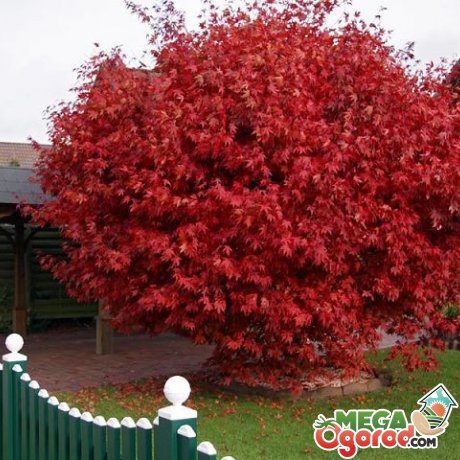
Among the varieties of ornamental trees, one can name the red-leaved peach, the bignoniform catalpa, the willows of Matsudana, Tortuosa, Kilmarnock, Syrian hibiscus, Variegata deren, birches.
Description of varieties:
- The red-leaved peach does not produce fruit, but is valued for the beautiful burgundy leaves that it got from Pissardi's cherry plum. It is she who is the ancestor of the red-leaved peach. The plant is grown in groups, where its leaves set off green trees, or singly.
- Bignonian catalpa is beautiful during flowering. Its flowers are in the form collected in a brush. Large ovate leaves and long pod-shaped fruits, up to 50 cm, adorn the plant in summer. They do not turn yellow in autumn. The plant is not very cold hardy. Therefore, young plants are sheltered for the winter. It grows well on fertile slightly acidic soils. Requires a lot of light, moisture. Flowering begins at the age of five. Grows up to 100 years. Care consists of weeding, regular watering once a week. Feed with rotted manure.
- The willows of Matsudana and Tortuosa are very decorative, with winding ropes. The Matsudana willow has ascending branches, olive color. The leaves are twisted. It is beautiful in summer and winter, when its beautiful branches become visible. Planted both singly and in groups. It can freeze in severe frosts, but quickly recovers in spring. Matsudana willow can be propagated.
- Willow Tortuosa differs from the willow Matsudan dense crown, winding branches, yellow or reddish. Looks good near artificial or natural reservoirs.
- Kilmarnock goat willow is a small tree grafted on a trunk up to 2 m high. The leaves are oval, pubescent below. In spring they turn yellow. Fragrant earrings adorn it before the leaves bloom. Pruning can form the original crown. It tolerates frost well, can grow in partial shade. Likes moist soil. But from excess water, its root system can rot.
- Syrian hibiscus is not very cold hardy. Differs in huge (7 cm) bright flowers of various colors, from white to red and purple. Grows well in southern regions. There you can grow varieties with double flowers. In the more northerly, it is better to use with simple flowers. Planted in the warmest and most sheltered places in the garden.
- Derain Variegata is valued for the original color of the leaves. In winter, it attracts with its bright multi-colored branches, from yellow to burgundy. There is one type of turf. Grow it as a shrub or tree. Likes calcareous soils. Grows up to 400 years.
- White birches are well known and widespread. But besides them there are many interesting species of this tree. Among them are woolly birch and Erman, whose rounded catkins are directed upwards. Species with egg-shaped leaves (ribbed, cherry, Schmidt). Almost all of them are frost-resistant and photophilous. Grows on any light soil. They do not like soil compaction around the trunk.
More information can be found in the video.
Many owners of their own houses, summer cottages dream of creating a beautiful and fertile garden in their backyard, where summer time it will be great to relax in the shade and enjoy the taste of fruits and berries from the trees. However, in order for the trees to bear as many fruits as possible, they have enough light and fertile soil, you must first choose the right trees for the size of your garden. In this article, we will take a closer look at how to choose, plant and care for a young fruit and berry or exotic garden. Also in our article will be presented high-quality photos of beautiful trees for the garden.
How to choose the right trees according to the parameters of the garden
First of all, let's get acquainted with the size of the trees. For small areas, it is best to choose dwarf breeds. If your garden is medium in size, then in this case you can plant fruit and berry and ornamental trees of medium and small height. For example, you can plant apple trees, hawthorn, thuja, birch, bird cherry, which do not grow above 10 meters.
Important. Trees of the varieties described above very rarely exceed the house, thereby not closing it from view. Also, branches or falling fruits will not be able to damage the roof or cladding of the house.
Before choosing trees for planting, it is necessary to pay attention to the texture of foliage and branches. You should carefully choose a landing site. For example, if you want to hide the flaws in your home, it is best to plant coniferous trees. You can plant spruce, thuja, which will close the space from prying eyes within a radius of 4 meters and become a beautiful hedge. To create shade, it is best to use broad-leaved trees, such as maple, cherry, etc.
Recommendation. Do not use tall trees in the garden that will cover other trees from the sun. In addition, some tree species such as maple or birch consume a lot of water, draining your yard, requiring additional irrigation.
The soil
It is imperative to study the soil in your area, as many varieties of trees are quite demanding. Deciduous varieties of trees love moisture, such as aspen, birch. Pine from excess moisture can die. That is why for soil with excess moisture it is best to use garden special varieties of trees.
Today, the following types of trees are increasingly used for arranging a garden:
- traditional trees;
- exotic;
- shrubs.
traditional trees
Every year there are more and more exotic and decorative varieties of trees that allow you to decorate any garden. However, for many years traditional tree varieties have proven to be unpretentious, frost-resistant and fertile.
Traditional trees, in turn, are divided into:
- coniferous;
- deciduous;
- fruit.
Varieties of coniferous trees for the garden:
- fir;
- larch;
- cedar;
- Pine.
Evergreen varieties of trees are distinguished by unfading beauty, unsurpassed aroma and unpretentiousness to living conditions.
To date, there are already more than 50 varieties of spruce. With the help of an evergreen tree, you can create an amazing landscape design, a beautiful hedge with an indescribable coniferous aroma.
Spruce can be represented:
- with a wide cone-shaped crown;
- narrowly growing crown;
- whorled arrangement of branches;
- hard needles;
- soft needles;
- with blue color;
- with silver color;
- with green color;
- etc.
Traditional spruce can reach a height of tens of meters, for this reason, it is worth planting it only away from the house or buildings, and if you have a large plot of land. There are also decorative fir trees, which, as a rule, do not grow above 5-6 meters. Spruce retains its pyramidal crown and color throughout the year.
Traditional varieties of beautiful deciduous trees for the garden:
- maple;
- Rowan;
- Birch;
- bird cherry;
- chestnut;
- elm, etc.
rowan birch
Bird cherry Chestnut
Oak 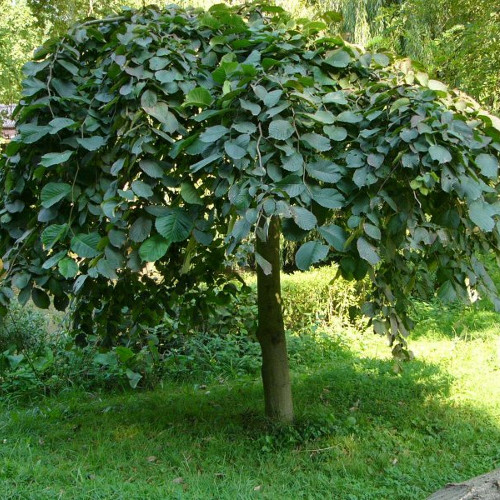 Elm
Elm
Deciduous varieties of trees will be a great decoration for every garden, creating a pleasant aroma, coolness and shade in the hot season.
red maple
A very beautiful tree with purple foliage that will adorn any modern garden. With the correct formation of the crown, you can get an ornamental plant with beautiful spreading branches.
Red maple may vary:
- crown size;
- height from 2 to 20 meters;
- structure;
- foliage coloring;
Maple prefers the following favorable conditions:
- partially shaded or sunny area;
- acidic, permeable moist soils;
Traditional varieties of fruit trees:
- pears;
- peaches;
- apple trees;
- plums;
- cherries;
- cherries;
- apricots, etc.
Fruit varieties of trees are distinguished by beautiful lush flowering, amazing aroma, large juicy fruits and beautiful leaves.
pear peach
Plum Cherry
Cherry Apricot
Apple tree
The apple tree is the most popular garden tree in the world. Juicy and delicious fruits, beautiful lush color, unpretentiousness to the habitat allow you to plant an apple tree on almost any soil.
Apple trees are divided into:
- summer - early;
- autumn - medium;
- winter - late.
To date, there are several hundred different varieties of apple trees, from dwarf to tall. Depending on the degree of ripening, fruit variety, each type of apple tree requires different conditions for maturation and care.
Apple trees prefer the following favorable conditions:
- sunny territory;
- well fertilized land;
- acidic, slightly moist soils;
- area protected from frost and strong winds.
exotic trees
With the help of exotic trees, you can create a colorful landscape design, where the indescribable aroma of flowering will soar.
Among the most popular and unpretentious exotic trees are:
- Cercis;
- Bougainvillea;
- Euonymus is winged;
- Bobovnik angirolistny;
- Fothergill;
- Sakura and others
Cercis Bougainvillea
Winged Euonymus Sakura
Exotic trees prefer the following favorable conditions:
- acidic, slightly moist or dry soils;
- sunny territory;
- well fertilized land;
- area protected from frost and strong winds.
Of course, today not one landscape design can do without exotic trees and shrubs. Bright and colorful colors, great fragrance and amazing appearance create an indescribable landscape on the plot.
bougainvillea
French ornamental tree, which is represented by 12 different varieties. Differs in amazing red flowering and pleasant aroma. Increasingly, Bougainvillea is used to decorate arbors and recreation areas. Quite unpretentious and very beautiful tree.
shrubs
On the backyard, shrubs are increasingly our use in creating landscape design. Amazing bright flowers, pleasant aroma and the ability to create almost any form of shrubs allowed them to be used in every household plot.
The most popular and picky varieties of shrubs:
- Barberry;
- Forsythia;
- Magonia;
- Rhododendron;
- Camellia etc.
Forsythia Magonia
Rhododendron Camellia
Barberry
The barberry has found wide application as a soil decoration for landscaping. Differs in decorative mulch of a contrasting shade, easily transfers pruning and gives in to formation. Barberry is often used to create hedges. Available in purple, red, and yellow.
How to properly care for trees in the garden
In order for your trees in the garden to delight you with their pleasant aroma, beautiful flowering, juicy fruits and coolness in the hot season, you need to properly care for them throughout the year.
We divide the tree care period into four seasons:
spring. We free the trees from snow, cover up all the damage, it is necessary to carefully process and close it with a protective film. With the temperature rising above 0, we proceed to pruning trees. When the snow has melted, we harrow the soil, fertilize the trees and plant new ones. On ornamental and exotic trees and shrubs, we form a crown, structure by cutting branches. We remove protective and warming material from decorative trees and young ones. Trees can be grafted during this period. In May, we spray the buds from pests.
Summer. We spray our garden against insects and diseases. We loosen the soil, feed and fill the plants well with water. We remove weeds, in August we spray pesticides again. We harvest from fruit and berry trees.
Autumn. We collect the remaining fruits from fruit and berry trees, proceed to planting seedlings. Decorative and young trees are prepared for winter, covered with protective and insulating material.
in winter. Loose snow first needs to spud ornamental trees and shrubs.
How to arrange trees in the garden
Depending on the size of the garden, soil type, climate zone, trees can be planted either singly or in groups. In the event that trees are planned to be planted in a group, then you should ensure that they form a single composition:
- matched size;
- the color of the foliage was combined;
- combined texture;


